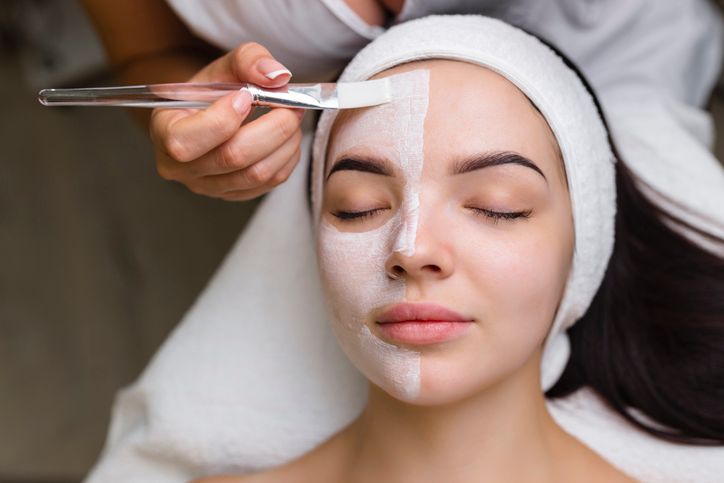- Home
- Trend
- Weight Loss Strategies
- Acne Tips
- Hair Health Information
- Blemish Removal Tips
- Acne Scar Removal Tips
- Muscle Building Techniques
- Intimate Care Tips
- Postpartum Intimate Care
- Eye Bags Wiki
- Tips for Face Slimming
- Secret of Permanent Hair Removal
- Breast Enlargement Tips
- Cure to Snoring
- Marionette Lines
- Skin-Tightening Secrets
In recent years, chemical exfoliation has become increasingly popular in skincare routines. More and more people are purchasing acid-based products to perform exfoliation treatments at home. While fruit acid (AHA) peels can be very effective, their acidic nature can also irritate the skin or even cause adverse reactions. That’s why caution is essential when doing chemical peels at home.
This article offers a comprehensive look at chemical exfoliation, covering how it works, the benefits of different acid types, and the correct steps for safe exfoliation.
What is Chemical Exfoliation?

Chemical exfoliation is a skincare technique that uses acid-based products to treat various skin issues and enhance overall skin condition. Depending on individual needs, users apply different acids to promote skin cell turnover and shed dead skin, which helps prevent blackheads, whiteheads, and acne. It can also brighten the complexion and improve uneven skin tone.
Although exfoliation can be irritating, dermatologists note that when done correctly, it activates skin cells and stimulates the production of healthy new cells, improving many skin concerns. The type and concentration of acid used also matter. While high concentrations can deliver stronger results, they come with increased risk. For gentler, safer home use, dermatologists recommend products with low-concentration retinoids (A-retinol), which are effective and more skin-friendly.
The 5 Major Benefits of Chemical Peels

i. Minimizes Large Pores
One of the key benefits of acid exfoliation is pore refinement. Our skin's outermost layer, the stratum corneum, naturally renews every 28 days. However, aging and lifestyle factors can slow this process, leading to buildup of dead skin, oil, and dirt—ultimately enlarging pores. Acid exfoliation helps remove this buildup, unclogs pores, and restores them to a more refined size.
ii. Treats Acne
Excess oil production is a major cause of acne. When too much oil clogs pores, blackheads and whiteheads form, which can become inflamed and turn into pimples. Fruit acids penetrate the skin to eliminate acne-causing bacteria and reduce oil secretion, helping to prevent future breakouts.
Note: People with severe acne should avoid exfoliation with strong acids, as the irritation may worsen already inflamed skin.
iii. Brightens Skin Tone
UV exposure, lack of sleep, and poor diet can lead to dull or uneven skin. Chemical peels help break down melanin at the deeper layers, resulting in a brighter, more radiant complexion. Some acids can also target redness and reduce broken capillaries.
iv. Improves Skin Texture
Fruit acids strengthen the skin barrier and enhance the skin’s ability to defend against external damage. By clearing dead skin cells, they also improve the absorption of serums and moisturizers, making your skincare routine more effective overall.
v. Delays Aging
Fruit acids inhibit free radicals and slow down oxidation, helping to combat aging signs like wrinkles and fine lines. Many also have hydrating properties that keep skin plump and elastic.
免費體驗
Acne Treatment
1 Minute Self-Registration
Date should not be before minimal date
Choosing the Right Acid: 5 Popular Types and Their Benefits
i. Salicylic Acid (BHA)
Oil-soluble and known for deep pore cleansing, it removes sebum and dead skin from within pores, making it ideal for oily, combination, or acne-prone skin. It also has anti-inflammatory and pain-relieving properties.
ii. Mandelic Acid
Mildly oil-soluble, it helps exfoliate and treat blackheads and whiteheads. Its large molecular size means it penetrates slowly, causing less irritation—making it more suitable for sensitive skin.
iii. Glycolic Acid
A water-soluble AHA with the smallest molecular size, it penetrates deeply and quickly to remove dead skin cells. It’s excellent for dry skin and also helps fade pigmentation and acne scars.
For home use, choose glycolic acid products with under 5% concentration. Medical-grade formulas (20–30%) are best left to professionals.
iv. Lactic Acid
Also water-soluble, this gentle acid is safe for sensitive, dry, or combination skin. Upon contact with skin, it converts into natural moisturizing factors, making it excellent for hydration.
v. Azelaic Acid
Known for its low acidity (even milder than white vinegar), it’s a great option for sensitive skin or those looking for gentle maintenance. It boosts cell turnover, fades scars, and evens skin tone.
Correct Steps for At-Home Exfoliation
Since acids can be irritating, proper usage is essential:
1. Patch Test First
If you’re new to acid peels, test a small amount on your neck, behind the ear, or inner arm to check for allergic reactions.
2. Step 1: Cleanse Thoroughly
Remove all makeup and grime using a gentle cleanser. Residual oils or makeup can hinder acid absorption and reduce effectiveness.
3. Step 2: Apply Evenly
Dry your face completely and use a brush or cotton pad to apply the acid evenly. If your skin is sensitive, limit application to problem areas like the T-zone or acne spots.
4. Step 3: Wait & Rinse
Let the product sit for about five minutes, then rinse thoroughly with water.
5. Step 4: Moisturize
After exfoliating, your skin will be more sensitive. Use mild, hydrating skincare products and avoid anything harsh to prevent adverse reactions.
5 Common Misconceptions About Chemical Peels
i. Myth: Everyone Can Do Chemical Peels
Not true. Sensitive skin types are more prone to adverse reactions like redness, itching, and peeling. Sensitive-skin users should only exfoliate when skin is stable, and limit treatments to once a month.
ii. Myth: Higher Acid = Better Results
Stronger acids might seem more effective, but they also pose greater risks. Dermatologists advise beginners or home users to stick to low-concentration acids.
iii. Myth: Exfoliation Thins the Skin
Actually, removing dead skin promotes regeneration. It doesn't thin the living layers of your skin. Over-exfoliation, however, can cause issues—so don’t overdo it.
iv. Myth: You Can Mix Different Acids
Different acids have unique properties, and combining them can overly irritate the skin. If using multiple acids, apply them to different zones based on specific needs.
v. Myth: Post-Peel Skincare Isn’t Important
After exfoliation, focus on sun protection and hydration. Use physical (non-chemical) sunscreens and avoid strong active ingredients. Stick with gentle, hydrating formulas.
免費體驗
Acne Treatment
1 Minute Self-Registration
Date should not be before minimal date
Perfect Medical Acne Treatment: A Gentle, Effective Alternative to Peels
While acid peels offer many benefits, they aren’t suitable for everyone due to their intensity. Improper use can worsen skin problems. If you're looking for a safer way to manage skin concerns, try Perfect Medical’s Acne Treatment!
This non-invasive treatment helps prevent acne and balances oil and moisture levels. It uses advanced vacuum exfoliation to gently clear out oil, dead skin, acne bacteria, and dirt. At the same time, it delivers deep hydration with potent medical-grade serums to boost skin repair. The treatment also stimulates collagen production, restoring elasticity and smoothing out acne scars.
For those wary of harsh acid peels, this is a gentler and more effective option—and you can even try it for free with Perfect Medical’s introductory offer!
Free Trial: Perfect Medical Acne Treatment免費體驗
Acne Treatment
1 Minute Self-Registration
Date should not be before minimal date
FAQ

What are the benefits of skin resurfacing?
Skin resurfacing offers a range of benefits, such as promoting the shedding of dead skin cells, minimizing pores, improving acne, and brightening and evening out skin tone.
How often can I do skin resurfacing?
As resurfacing can be somewhat irritating to the skin, it’s not recommended to do it too frequently. People with oily skin can do it once a week, while those with dry, normal, or combination skin are advised to do it every two weeks. For sensitive skin, it’s generally not recommended unless necessary.
What side effects can skin resurfacing cause?
Improper procedures or using acids with unsuitable concentrations can easily lead to side effects. Common adverse reactions to incorrect resurfacing include itching, redness, dryness, and peeling. In more severe cases, it can even cause skin inflammation.
How do you correctly perform skin resurfacing?
The first step is cleansing the face. Use makeup remover or facial cleanser to thoroughly clean the skin to prevent dirt from blocking the acid’s absorption. Then, apply the acid evenly over the face. After about five minutes, rinse your face with water. Finally, follow your usual skincare routine.
Can I use a face mask after skin resurfacing?
Since the skin becomes more sensitive after resurfacing, all post-care should be kept gentle and simple, with products focusing mainly on hydration. If you wish to use a face mask, it’s best to choose a hydrating one to avoid overburdening the skin.









